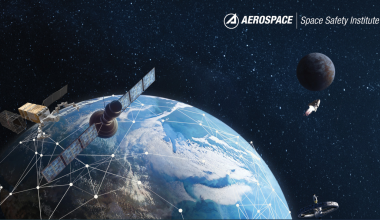Commercial launch providers and their innovative solutions have disrupted the classical approach of conducting comprehensive launch system safety reviews to verify flightworthiness. Today’s nuanced launch ecosystem calls for a spectrum of approaches to launch safety based on individual operators’ needs and limitations. Through the Space Safety Institute (SSI), The Aerospace Corporation’s unique flight readiness verification process is adapted to today’s agile environment to provide flexible, cost-effective launch safety assurance to customers.
SSI also leverages Aerospace’s Center for Orbital and Reentry Debris Studies (CORDS) to improve reentry safety and better understand the hazards breakup events pose, including metallurgical research and in situ data collected during the reentry and breakup of a vehicle.
Independent Assessments
Aerospace’s rigorous and tailorable launch verification process, which encompasses every technical discipline, reviews system design, engineering, manufacturing, assembly, integration, and preflight operations—is traceable to the Mercury-Atlas and Gemini-Titan programs of the 1960s. Aerospace is also a leader in developing reentry hazard assessment tools that reflect findings of its independent research in this area. SSI uses these tools to:
- Provide independent assessments of contractor survivability and hazard predictions
- Develop hazard estimates associated with the reentry of government and commercial satellites
- Assess and inform discussions on risks and requirements for satellite disposal and small debris that might survive reentry
- Provide independent verification of launch vehicle and spacecraft compliance with existing reentry hazard minimization policies
Standards and Best Practices
SSI helps the space enterprise develop international standards that capture best practices for minimizing hazards associated with reentry disposal of space hardware, extending Aerospace’s intimate knowledge of the components of launch and space systems and of their past failures and anomalies.
Aerospace’s proprietary Acquisition Support and Systems Engineering Tool (ASSET) database, established in 1962, maintains detailed descriptions and findings related to off-nominal incidents associated with virtually all launch and space vehicles, including anomaly data down to the component level. This detailed approach supports overall reliability improvements and has been captured in standards and best practices that have lowered launch and space vehicle failure rates for decades.
Space debris mitigation policies specify that objects disposed of into the atmosphere must limit the hazards to people on the ground. Aerospace has helped develop international standards for estimating ground hazards and provided in situ data on reentry breakup of space vehicles that has refined hazard prediction models worldwide.
Policy and Strategy
Traditional methods of launch and planned reentry safety—including flight plan approvals, closures of air and marine spaces, and assurance of destruction systems—will be challenged with increasing operational tempos and responsiveness. Launches and planned reentries are international events that cross oceans and international borders and will benefit from international standards to ensure public safety. SSI can assist in addressing alternatives that allow the integration of launch traffic into air and marine traffic as vehicles become more reliable and operations become more routine, as well as on issues associated with environmental impacts of launch and reentry.
Previous: Space Operations Assurance Next: Cybersecurity and Spectrum




